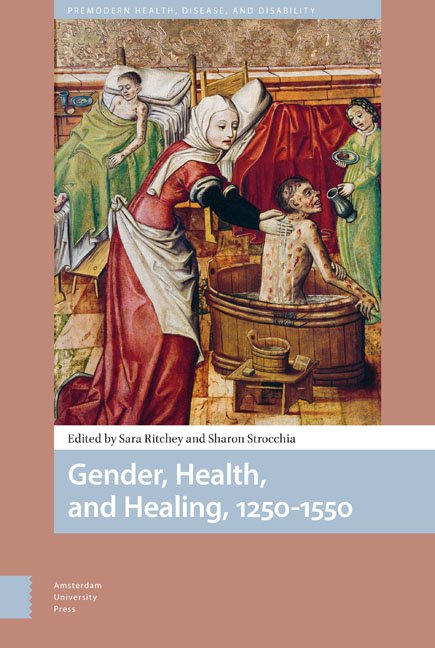Book contents
- Frontmatter
- Contents
- List of Figures and Tables
- Acknowledgments
- Abbreviations
- Introduction: Gendering Medieval Health and Healing: New Sources, New Perspectives
- Part 1 Sources of Religious Healing
- 1 Caring by the Hours: The Psalter as a Gendered Healthcare Technology
- 2 Female Saints as Agents of Female Healing: Gendered Practices and Patronage in the Cult of St. Cunigunde
- Part 2 Producing and Transmitting Medical Knowledge
- 3 Blood, Milk, and Breastbleeding: The Humoral Economy of Women's Bodies in Medieval Medicine
- 4 Care of the Breast in the Late Middle Ages: The Tractatus de passionibus mamillarum
- 5 Household Medicine for a Renaissance Court: Caterina Sforza's Ricettario Reconsidered
- 6 Understanding/Controlling the Female Body in Ten Recipes: Print and the Dissemination of Medical Knowledge about Women in the Early Sixteenth Century
- Part 3 Infirmity and Care
- 7 Ubi non est mulier, ingemiscit egens?: Gendered Perceptions of Care from the Thirteenth to Sixteenth Centuries
- 8 Domestic Care in the Sixteenth Century: Expectations, Experiences, and Practices from a Gendered Perspective
- 9 Bathtubs as a Healing Approach in Fifteenth-Century Ottoman Medicine
- Part 4 (In)fertility and Reproduction
- 10 Gender, Old Age, and the Infertile Body in Medieval Medicine
- 11 Gender Segregation and the Possibility of Arabo-Galenic Gynecological Practice in the Medieval Islamic World
- Afterword: Healing Women and Women Healers
- Contributors
- Index
8 - Domestic Care in the Sixteenth Century: Expectations, Experiences, and Practices from a Gendered Perspective
Published online by Cambridge University Press: 23 June 2021
- Frontmatter
- Contents
- List of Figures and Tables
- Acknowledgments
- Abbreviations
- Introduction: Gendering Medieval Health and Healing: New Sources, New Perspectives
- Part 1 Sources of Religious Healing
- 1 Caring by the Hours: The Psalter as a Gendered Healthcare Technology
- 2 Female Saints as Agents of Female Healing: Gendered Practices and Patronage in the Cult of St. Cunigunde
- Part 2 Producing and Transmitting Medical Knowledge
- 3 Blood, Milk, and Breastbleeding: The Humoral Economy of Women's Bodies in Medieval Medicine
- 4 Care of the Breast in the Late Middle Ages: The Tractatus de passionibus mamillarum
- 5 Household Medicine for a Renaissance Court: Caterina Sforza's Ricettario Reconsidered
- 6 Understanding/Controlling the Female Body in Ten Recipes: Print and the Dissemination of Medical Knowledge about Women in the Early Sixteenth Century
- Part 3 Infirmity and Care
- 7 Ubi non est mulier, ingemiscit egens?: Gendered Perceptions of Care from the Thirteenth to Sixteenth Centuries
- 8 Domestic Care in the Sixteenth Century: Expectations, Experiences, and Practices from a Gendered Perspective
- 9 Bathtubs as a Healing Approach in Fifteenth-Century Ottoman Medicine
- Part 4 (In)fertility and Reproduction
- 10 Gender, Old Age, and the Infertile Body in Medieval Medicine
- 11 Gender Segregation and the Possibility of Arabo-Galenic Gynecological Practice in the Medieval Islamic World
- Afterword: Healing Women and Women Healers
- Contributors
- Index
Summary
Abstract
This essay combines a gendered approach with a perspective on the spatial, material, and performative dimensions of care practices within sixteenth-century German domestic environments. Terminological and semantic challenges of premodern and modern vocabularies are discussed first. The essay questions dichotomies between public, communal, and institutional care versus private, domestic care in light of the collaboration between internal and external experts and the collective nature of infirmity and caregiving. Using a case study of written and pictorial instructions in an illustrated surgeon's manual, the essay suggests the value of interdisciplinary approaches to the field of premodern care.
Keywords: spatial environment, material environment, performance of care, body, bed, terminology
Unlike institutional care, domestic care in the premodern era has only recently begun to emerge as a field of interdisciplinary research. New perspectives on social groups and networks, body history, dis/ability history, and other overlapping approaches have favoured a shift of focus towards caregiving within families, households, friendships, and neighbourhoods. Microhistorical and case studies have unearthed a number of formerly unknown or disregarded sources that shed light on the practices and spaces, organization, and financing of domestic or ‘private’ care for infirm persons. Scholars using the lens of gender have added details and contours to formerly general notions that in premodern societies both women and men actively engaged in caregiving and were cared for. Domestic caregiving was identified as an acknowledged field of female and male work within late medieval and early modern urban economies. Linking communal and private spheres, it created and shaped social nets between women and men of different social strata.
Still, many aspects of domestic care have not yet been examined systematically. There are few studies that cross disciplinary borders or proceed comparatively. General assumptions that within households women were more often associated with active care than men, or that specific activities were performed in accordance with gender-related norms and expectations, have to be tested by scrutinizing written, visual, and material evidence. Also, some basic questions should be considered in order to assess the extent to which premodern domestic care was a gendered field of action. Above all, what is the meaning of ‘domestic care’ with regard to premodern societies?
- Type
- Chapter
- Information
- Gender, Health, and Healing, 1250–1550 , pp. 215 - 244Publisher: Amsterdam University PressPrint publication year: 2020
- 3
- Cited by



